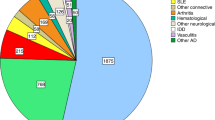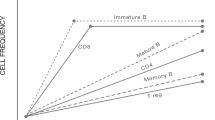Abstract
Autologous haematopoietic SCT (AHSCT) is increasingly used to control severe and refractory autoimmune diseases (AD). Many patients are women of reproductive age with a potential desire for children. We present a multicentre retrospective analysis of pregnancy and childbirth in patients who underwent AHSCT for AD. The databases of the European Blood and Marrow Transplantation and University of Sao Paulo, Ribeirão Preto, Brazil were searched for female patients aged 18–50 years who had received AHSCT for AD between 1994–2011. In 324 adult female patients, 22 pregnancies were reported in 15 patients between 1997–2011. Indications for AHSCT included multiple sclerosis (n=7), systemic sclerosis (n=5), rheumatoid arthritis (n=1), juvenile idiopathic arthritis (n=1) and Takayasu disease (n=1). Of the 22 reported pregnancies, 20 followed natural conception. 15 pregnancies (68%) resulted in healthy life births, whereas 7 (32%) failed. Exacerbations of AD occurred in two patients during second pregnancies. No maternal mortality was associated with pregnancy or postpartum. There were no reports of congenital, developmental or any other disease in the children. This retrospective analysis confirms the possibility of pregnancy and childbirth following AHSCT for severe AD. The outcome of pregnancy is generally good and most led to the birth of a healthy child.
This is a preview of subscription content, access via your institution
Access options
Subscribe to this journal
Receive 12 print issues and online access
$259.00 per year
only $21.58 per issue
Buy this article
- Purchase on Springer Link
- Instant access to full article PDF
Prices may be subject to local taxes which are calculated during checkout
Similar content being viewed by others
References
Snowden JA, Saccardi R, Allez M, Ardizzone S, Arnold R, Cervera R et al. Haematopoietic stem cell transplantation (HSCT) in severe auto-immune diseases (ADs): updated guidelines of the European Group for Blood and Marrow Transplantation (EBMT). Bone Marrow Transplant 2012; 47: 770–790.
Loren AW, Chow E, Jacobsohn DA, Gilleece M, Halter J, Joshi S et al. Pregnancy after hematopoietic cell transplantation: a report from the late effects working committee of the Center for International Blood and Marrow Transplant Research (CIBMTR). Biol Blood Marrow Transplant 2011; 17: 157–166.
Carter A, Robison LL, Francisco L, Smith D, Grant M, Baker KS et al. Prevalence of conception and pregnancy outcomes after hematopoietic cell transplantation: report from the Bone Marrow Transplant Survivor Study. Bone Marrow Transplant 2006; 37: 1023–1029.
Absolom K, Eiser C, Turner L, Ledger W, Ross R, Davies H et al. Ovarian failure following cancer treatment: Current management and quality of life. Hum Reprod 2008; 23: 2506–2512.
Snowden JA, Biggs JC, Milliken S, Fuller A, Brooks PM . A phase I/II dose escalation study of intensified cyclophosphamide with autologous blood stem cell rescue in patients with severe active rheumatoid arthritis. Arthritis Rheum 1999; 42: 2286–2292.
Tyndall AJ, Joly F, Carbonne B, Deligny CN, Farge DC . Pregnancy and childbirth after treatment with autologous hematopoietic stem cell transplantation for severe systemic sclerosis requiring parenteral nutrition. Clin Exp Rheumatol 2008; 26: 1122–1124.
Nabhan SK, Bitencourt MA, Duval M, Abecasis M, Dufour C, Boudjedir K et al. Fertility recovery and pregnancy after allogeneic hematopoietic stem cell transplantation in Fanconi anemia patients. Haematologica 2010; 95: 1783–1787.
Hohmann C, Borgmann-Staudt A, Rendtorff R, Reinmuth S, Holzhausen S, Willich SN et al. Patient counselling on the risk of infertility and its impact on childhood cancer survivors: results from a national survey. J Psychosoc Oncol 2011; 29: 274–285.
Sanders JE, Buckner CD, Amos D, Levy W, Appelbaum FR, Doney K et al. Ovarian function following marrow transplantation for aplastic anemia or leukemia. J Clin Oncol. 1988; 6: 813–818.
Sanders JE, Hawley J, Levy W, Gooley T, Buckner CD, Deeg HJ et al. Pregnancies following high dose cyclophosphamide with or without high dose busulphan or total body irradiation and bone marrow transplantation. Blood 1996; 87: 3045–3052
Reinmuth S, Hohmann C, Rendtorff R, Balcerek M, Holzhausen S, Müller A et al. Impact of chemotherapy and radiotherapy in childhood on fertility in adulthood: the FeCt-survey of childhood cancer survivors in Germany. J Cancer Res Clin Oncol 2013; 139: 2071–2078.
Marsh JC, Ball SE, Cavenagh J, Darbyshire P, Dokal I, Gordon-Smith EC et alBritish Committee for Standards in Haematology. Guidelines for the diagnosis and management of aplastic anaemia. Br J Haematol. 2009; 147: 43–70.
Author information
Authors and Affiliations
Corresponding authors
Ethics declarations
Competing interests
The authors declare no conflict of interest.
Additional information
Author Contributions
ES, JAS and DF were the principal investigators and take primary responsibility for the paper; they had full access to all the data in the study and take responsibility for the integrity of the data and the accuracy of the data analysis. Study concept and design: ES, JAS and DF. Acquisition of data: MB, DF, SHK, JAS, JM, MM, AC, JT, TM, MR, AS, MCO, BPS, RC, CC and JB recruited the patients. Drafting of the manuscript: ES, JS and DF. Statistical analysis: MB and ML. Administrative, technical or material support: EBMT.
Rights and permissions
About this article
Cite this article
Snarski, E., Snowden, J., Oliveira, M. et al. Onset and outcome of pregnancy after autologous haematopoietic SCT (AHSCT) for autoimmune diseases: a retrospective study of the EBMT autoimmune diseases working party (ADWP). Bone Marrow Transplant 50, 216–220 (2015). https://doi.org/10.1038/bmt.2014.248
Received:
Revised:
Accepted:
Published:
Issue Date:
DOI: https://doi.org/10.1038/bmt.2014.248
This article is cited by
-
Selective cognitive dysfunction and physical disability improvement after autologous hematopoietic stem cell transplantation in highly active multiple sclerosis
Scientific Reports (2020)
-
Autologe hämatopoetische Stammzelltransplantation bei systemischer Sklerose
Zeitschrift für Rheumatologie (2020)
-
Haematopoietic Stem Cell Transplantation for Multiple Sclerosis: Current Status
BioDrugs (2020)
-
Autologous Hematopoietic Stem Cell Transplantation (AHSCT): Standard of Care for Relapsing–Remitting Multiple Sclerosis Patients
Neurology and Therapy (2020)
-
Autologous hematopoietic stem cell transplantation with reduced-intensity conditioning regimens in refractory Takayasu arteritis: a retrospective multicenter case-series from the Autoimmune Diseases Working Party (ADWP) of the European Society for Blood and Marrow Transplantation (EBMT)
Bone Marrow Transplantation (2020)



